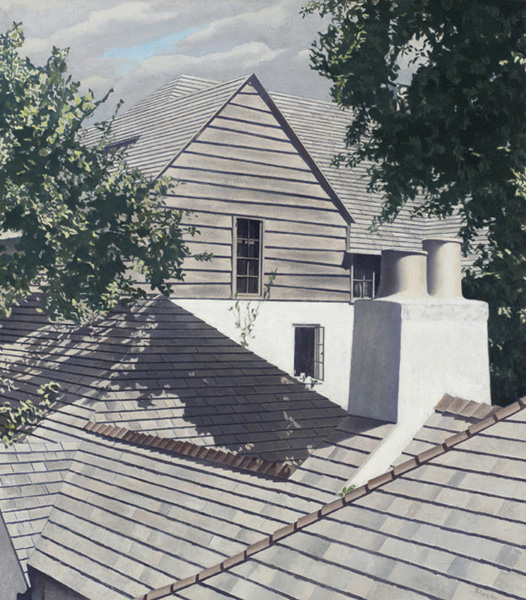
Clapboards
Charles Sheeler
Capturing the rise of industry through a meticulous realism, Sheeler was a prominent figure in American modernism before World War II. Born in Philadelphia, he studied art at the Pennsylvania Academy with William Merritt Chase. Early in his career, Sheeler supported himself as an architectural photographer in order to maintain his studio. From 1910 to 1919, he traveled to Bucks County on the weekends, photographing and painting subjects such as barns, farmhouses, and factories. During the 1920s, Sheeler became associated with artists now called the Precisionists, a term used to describe individuals who painted in a realistic style emphasizing a precise depiction of industrial subjects.
By 1929, Sheeler began to more overtly base his paintings on photography through a technique that combined the visual crispness of photographs with painterly effects. "Clapboards" reveals these concerns in the numerous parallel lines that carefully order this vision of suburban rooftops framed by the branches of two trees. The regularity of the forms displays Sheeler's interest in the underlying geometry and rational order that define the man-made world. While better known for his representations of industry and machinery, "Clapboards" shows Sheeler's continued interest in vernacular architecture.
Artist
Date of Birth
(1883-1965)
Date
1936
Medium
Oil on canvas
Dimensions
21 1/8 x 19 1/4 in. (53.6575 x 48.895 cm.)
Accession #
1939.19
Credit Line
Gift of W. Griffin Gribbel, R. Sturgis Ingersoll, John Frederick Lewis, Jr., William Clarke Mason, Henry T. McIlhenny, Lessing J. Rosenwald, Alfred G. B. Steel, Mrs. George F. Tyler, William L. Van Alen, and Joseph E. Widener
Copyright
© artist or artist's estate
Category
Subject
More by
We're so excited you're planning to visit PAFA!
Make time for art — visit us Thursday to Sunday.
Before reserving your tickets, please review helpful information about museum hours, accessibility, building access, and special admission programs.
If you have any questions, feel free to reach out to us at visitorservices@pafa.org — we’d love to help!